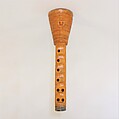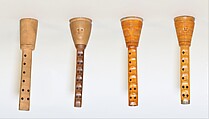Diple
Stipan Lukic Croatian
Not on view
The diple is a reed instrument found the Dalmatian region. Its distribution extends along the Adriatic coast from below Istria, Croatia, in the North all the way to southern Bosnia and Herzegovina in the south. The diple were played by shepherds, who brought the instrument along when herding animals. Due to the nature of the instrument, the diple is played using circular breathing in order to create a continuous sound. As this is a tiring technique, most diple players looked for a bag to attach to the instrument (Širola 1937:82), creating in the process a diple sa mješinom, the bagpipe version of the diple. However, mainly played the diple without a bag. The diple is mainly played as a solo instrument and has a strong improvisation tradition.
This instrument was made around 1930 by Stipan Lukić from Želovo in Croatia. Želovo was one of the main centres of diple-making in Dalmatia, along with Žegar and Otišić. Dalmatian diples are all very similar and only present slight organological differences. The melodic pipe is made out of a single piece of wood – usually maple, walnut or chestnut (Marković 1957:54) – within which two thin cylindrical bores were created. The right bore has six holes, and the left bore has two holes, which are used to change the pitch of the drone. The stock and melodic chanter are intricately carved with geometrical patterns. In a central position on the stock we find a human head, one of the defining aesthetical characteristics of diples across the Dalmatian region (Širola 1937:24-25). The type of head found on this stock is characteristic of the Želovo area: a small heart-shaped head with a pointed chin embedded in intricate geometrical designs. The cylindrical bores are each fitted with single reeds that are protected by the stock, and activated when the player presses the opening of the stock against their mouth.
This instrument was formerly owned by Božidar Širola (1889 - 1956). Širola was a specialist of Croatian music in the first half of the twentieth century. He was a composer, the curator and director of the Ethnographic Museum, the dean of the Music Academy of Zagreb, and a high school teacher (Brožek 1957). The instrument was part of the New York Public Library collection until 1976, when it was exchanged along with forty-two other instruments and six accompanying items for a collection of sheet music and music books held at the Metropolitan Museum.
(Cassandre Balosso-Bardin, 2023)
References
Brožek, Josef, 1957. Božidar Širola. Journal of the International Folk Music Council, 9, 77-77.
Marković, Zagroka, 1957. Narodni musićki instrumenti. Belgrade: Etnografski muzej
Širola, Božidar, 1937. Sviraljke sudarnim jezičkom. Zagreb: tisak nadbiskupske tiskare.
Due to rights restrictions, this image cannot be enlarged, viewed at full screen, or downloaded.
This artwork is meant to be viewed from right to left. Scroll left to view more.





